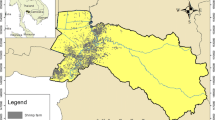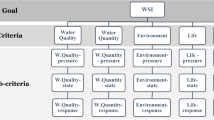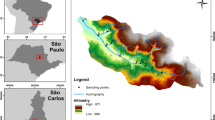Abstract
Any watershed project is a multi-stakeholder endeavour incorporating diverse socio-hydrological dimensions of a region. The project’s worth is correlated with the stakeholders’ willingness to continue. Identifying the most desirable watershed parameters is challenging for watershed managers. This research aims to explore critical parameters and construct a watershed project desirability indexing framework to examine the congruence of stakeholders’ perceptions on a hypothetical watershed parameter list. It contains 31 critical operational areas (or sub-domains) in eight domains incorporating different management mechanisms and socio-economic and environmental activities covering diverse watershed inventories based on watershed management protocols, including the Integrated Watershed Management Programme (IWMP), Integrated Water Resource Management Programme (IWRM), World Bank directives and government guidelines, and relevant literature. Stakeholders’ agreeability was recorded from two stratified stakeholder groups at the Satpokholi watershed project in the Brahmaputra Valley, India, using a structured questionnaire based on a 5-point Likert Scale. Subsequently, the degree of alignment of the perception of stakeholder groups regarding the sub-domains and domains and the relative desirability are evaluated by applying statistical and mathematical operations. Results reveal that this watershed project desirability indexing (WPDI) would help identify the congruency of views regarding adopted watershed domains and sub-domains. Applying the same WPDI, stakeholders’ desirability in two other adjacent watershed projects (Kaldia and Turkunijan) was evaluated. Findings were validated by a series of expert interviews, which shows the potential of this WPDI to assess different watershed projects operating in an analogous environment. This indexing method might be modified to manage and reengineer multi-stakeholder projects where incongruent perceptions exist.





Similar content being viewed by others
Data Availability
The datasets generated during and analysed during the current study are available from the corresponding author upon reasonable request.
References
Petit O (2016) Paradise lost? The difficulties in defining and monitoring integrated water resources management indicators. Curr Opin Environ Sustain 21:58–64. https://doi.org/10.1016/j.cosust.2016.11.006
Biswas AK (2009) Integrated water resources method is that, unlike many top-down evaluation strategies, 48–256. https://doi.org/10.1080/02508060408691775
Kenney DS (2000) Assessing the effectiveness of watershed initiatives: the current state of knowledge. (Natural Res. Law Ctr., Univ. of Colo. Sch. of Law 2000). Available: https://scholar.law.colorado.edu/cgi/viewcontent.cgi?article=1033&context=books_reports_studies&httpsredir=1&referer=. Accessed 7 Sept 2019
Barbara EAP, Israel A, Amy J, Schulz, Becker AB (1998) Review of community-based research: Assessing partnership approaches to improve public health. Available: https://pubmed.ncbi.nlm.nih.gov/9611617/. Accessed 24 Mar 2018
Carmona G, Varela-Ortega C, Bromley J (2013) Participatory modelling to support decision making in water management under uncertainty: two comparative case studies in the Guadiana river basin, Spain. J Environ Manage 128:400–12. https://doi.org/10.1016/j.jenvman.2013.05.019
Giordano M, Shah T (2014) From IWRM back to integrated water resources management. Int J Water Resour Dev 30(3):364–376. https://doi.org/10.1080/07900627.2013.851521
UNECE and OECD (2017) European Union water initiative plus for the eastern partnership countries final inception report EUWI No. May 2009, pp 1–10. Available: https://unece.org/DAM/env/water/npd/EUWI_Plus/EUWI__Inception_Report.pdf. Accessed 10 Dec 2019
FAO (2017) Watershed management in action: lessons learned from FAO field projects, Rome. https://doi.org/10.1659/mrd.mm230
Isobel W, Heathcote (2009) Integrated watershed management principles and practice, 2nd ed. Wiley, Hoboken. Available: https://books.google.co.in/books?uid=105515998470654000107&as_coll=4&source=gbs_lp_bookshelf_list&sort=custom. Accessed 29 Mar 2019
Hooper B (2010) River basin organization performance indicators: application to the Delaware River basin commission. Water Policy 12(4):461–478. https://doi.org/10.2166/wp.2010.111
Aayog NITI (2019) Composite water mangement index, pp 1–239. Available: https://niti.gov.in/writereaddata/files/new_initiatives/presentation-on-CWMI.pdf. Accessed 18 Jul 2023
Kumar Shukla A et al (2018) Population growth, land use and land cover transformations, and water quality nexus in the upper Ganga River basin. Hydrol Earth Syst Sci 22(9):4745–4770. https://doi.org/10.5194/hess-22-4745-2018
Shukla AK, Ojha CSP, Garg RD, Shukla S, Pal L (2020) Influence of spatial urbanization on hydrological components of the upper Ganga River basin, India. J Hazard Toxic Radioact Waste 24(4). https://doi.org/10.1061/(ASCE)HZ.2153-5515.0000508
Pathak S, Ojha CSP, Shukla AK, Garg RD (2019) Assessment of annual water-balance models for diverse Indian watersheds. J Sustain Water Built Environ 5(3). https://doi.org/10.1061/JSWBAY.0000881
Shukla AK, Pathak S, Pal L, Ojha CSP, Mijic A, Garg RD (2018) Spatio-temporal assessment of annual water balance models for upper Ganga Basin. Hydrol Earth Syst Sci 22(10):5357–5371. https://doi.org/10.5194/hess-22-5357-2018
Lemos MC, Manuel-Navarrete D, Willems BL, Caravantes RD, Varady RG (2016) Advancing metrics: models for understanding adaptive capacity and water security. Current opinion in environmental sustainability, vol 21. Elsevier, pp 52–57. https://doi.org/10.1016/j.cosust.2016.11.004
Aayog N (2019) Composite water management index in association with Ministry of Jal Shakti and Ministry of Rural Development, Government of India, New Delhi. Available: https://social.niti.gov.in/uploads/sample/water_index_report2.pdf(www.niti.gov.in). Accessed 18 Jul 2023
Sriyana I, De Gijt JG, Parahyangsari SK, Niyomukiza JB (2020) Watershed management index based on the village watershed model (VWM) approach towards sustainability. Int Soil Water Conserv Res 8(1):35–46. https://doi.org/10.1016/j.iswcr.2020.01.003
Wang G et al (2016) Integrated watershed management: evolution, development and emerging trends. J Res (Harbin) 27(5):967–994. https://doi.org/10.1007/s11676-016-0293-3
Kerr J (2007) Watershed management lessons from common property theory. Int J Commons 1(1). Available: http://www.thecommons.org. Accessed 26 Jan 2024
Gallego-Ayala J, Juízo D (2012) Performance evaluation of River Basin organizations to implement integrated water resources management using composite indexes. Phys Chem Earth 50–52:205–216. https://doi.org/10.1016/j.pce.2012.08.008
Smyle J, Lobo C, Milne G, Williams M (2014) Watershed development in India. Available: https://www.worldbank.org. Accessed 19 Sept 2023
Hurford BAP, Moschini F, Woolhouse GAF (2017) Critical success factors for resilient water infrastructure. Available: https://reliefweb.int/sites/reliefweb.int/files/resources/Working-Paper_Critical-success-factors-resilient-water-infrastructure_CDKN.pdf. Accessed 14 Feb 2021
Ontario C (2010) Integrated watershed management – Navigating Ontario’s future: integrated watershed management in Ontario. Conservation Ontario. Available: https://www.conservationontario.ca. Accessed 1 May 2020
Common guidelines for watershed development projects (2008) India: Government of India, pp 1–57. Available: http://slnaiwmpassam.gov.in/xfiles/CommonGuidelines2008.pdf. Accessed 23 Mar 2019
OECD principles on water governance (2015) https://www.oecd.org/cfe/regional-policy/OECD-Principles-on-Water-Governance.pdf. Accessed 21 Mar 21
Rouillard JJ, Benson D, Gain AK (2014) Evaluating IWRM implementation success: are water policies in Bangladesh enhancing adaptive capacity to climate change impacts? Int J Water Resour Dev 30:515–527. https://doi.org/10.1080/07900627.2014.910756
Ehler CN (2003) Indicators to measure governance performance in integrated coastal management. Ocean Coast Manag 46:335–345. https://doi.org/10.1016/S0964-5691(03)00020-6
Benchmarking of Watershed Management Outcomes - Operational Guidelines, 2015, Department of Land Resources, Ministry of Rural Development, Government of India, New Delhi. Available: https://dolr.gov.in/sites/default/files/Benchmarking%20of%20Watershed%20Management%20Outcomes%20-%20Operational%20Guidelines%2C%202015%20-%20English.pdf. Accessed 19 Sept 2023
NITI Aayog India (2017) India Composite Water Management Index. NITI Aayog, Government of India, India
Sreeja KG, Madhusoodhanan CG, Eldho TI (2015) Transforming river basins: post-livelihood transition agricultural landscapes and implications for natural resource governance. J Environ Manage 159:254–263. https://doi.org/10.1016/j.jenvman.2015.05.021
Ng ST, Wong YMW, Wong JMW (2012) Factors influencing the success of PPP at feasibility stage - A tripartite comparison study in Hong Kong. Habitat Int 36(4):423–432. https://doi.org/10.1016/j.habitatint.2012.02.002
Martilla JA, James JC (1977) Importance-performance analysis. J Mark 41(1):77–79. https://doi.org/10.2307/1250495
Huang Y-K, Fan W-S, Tsai M-C, Ho Y-H (2015) Using importance-performance analysis in evaluating Taiwan Blog e-Service quality. J Econ Bus Manage 3(3):338–345. https://doi.org/10.7763/joebm.2015.v3.206
Shia BC, Chen M, Ramdansyah AD (2016) Measuring customer satisfaction toward localization website by WebQual and Importance Performance Analysis (Case Study on AliexPress Site in Indonesia). Am J Industrial Bus Manage 06(02):117–128. https://doi.org/10.4236/ajibm.2016.62012
Salkind NJ (2017) Statistics for people who (think they) hate statistics, 6th ed. Sage Publications
Mansuri G et al (2004) Community-based and-driven development: a critical review. Available: https://econ.worldbank.org. Accessed 16 Sept 2023
World Water Assessment Programme (2015) (United Nations) and UN-Water. The United Nations World Water Development Report 2015. Available: https://www.unwater.org/publications/un-world-water-development-report-2015. Accessed 24 Aug 2023
Author information
Authors and Affiliations
Contributions
Conceptualisation: Bhabesh Mahanta, Arup Kumar Sarma, and Sashindra Kumar Kakoty. Methodology: Bhabesh Mahanta, Arup Kumar Sarma, and Sashindra Kumar Kakoty. Formal analysis and investigation: Bhabesh Mahanta. Writing—original draft preparation: Bhabesh Mahanta; writing—review and editing: Arup Kumar Sarma and Sashindra Kumar Kakoty; figure preparation and resources: Bhabesh Mahanta, Arup Kumar Sarma, and Sashindra Kumar Kakoty. Supervision: Arup Kumar Sarma and Sashindra Kumar Kakoty.
Corresponding author
Ethics declarations
Ethics Approval
This is an observational study and does not include any personal data from individual survey respondents. Hence, no ethical approval is required.
Informed Consent
was obtained from all individual participants included in the study. Verbal informed consent was brought before the interviews.
Competing Interests
The authors declare no competing interests.
Additional information
Publisher’s Note
Springer Nature remains neutral with regard to jurisdictional claims in published maps and institutional affiliations.
Annexure 1: Indicators
Annexure 1: Indicators
Table 9
Rights and permissions
Springer Nature or its licensor (e.g. a society or other partner) holds exclusive rights to this article under a publishing agreement with the author(s) or other rightsholder(s); author self-archiving of the accepted manuscript version of this article is solely governed by the terms of such publishing agreement and applicable law.
About this article
Cite this article
Mahanta, B., Sarma, A.K. & Kakoty, S.K. Harmonising Stakeholders’ Perspectives: a Watershed Project Desirability Index. Water Conserv Sci Eng 9, 10 (2024). https://doi.org/10.1007/s41101-024-00242-2
Received:
Revised:
Accepted:
Published:
DOI: https://doi.org/10.1007/s41101-024-00242-2




